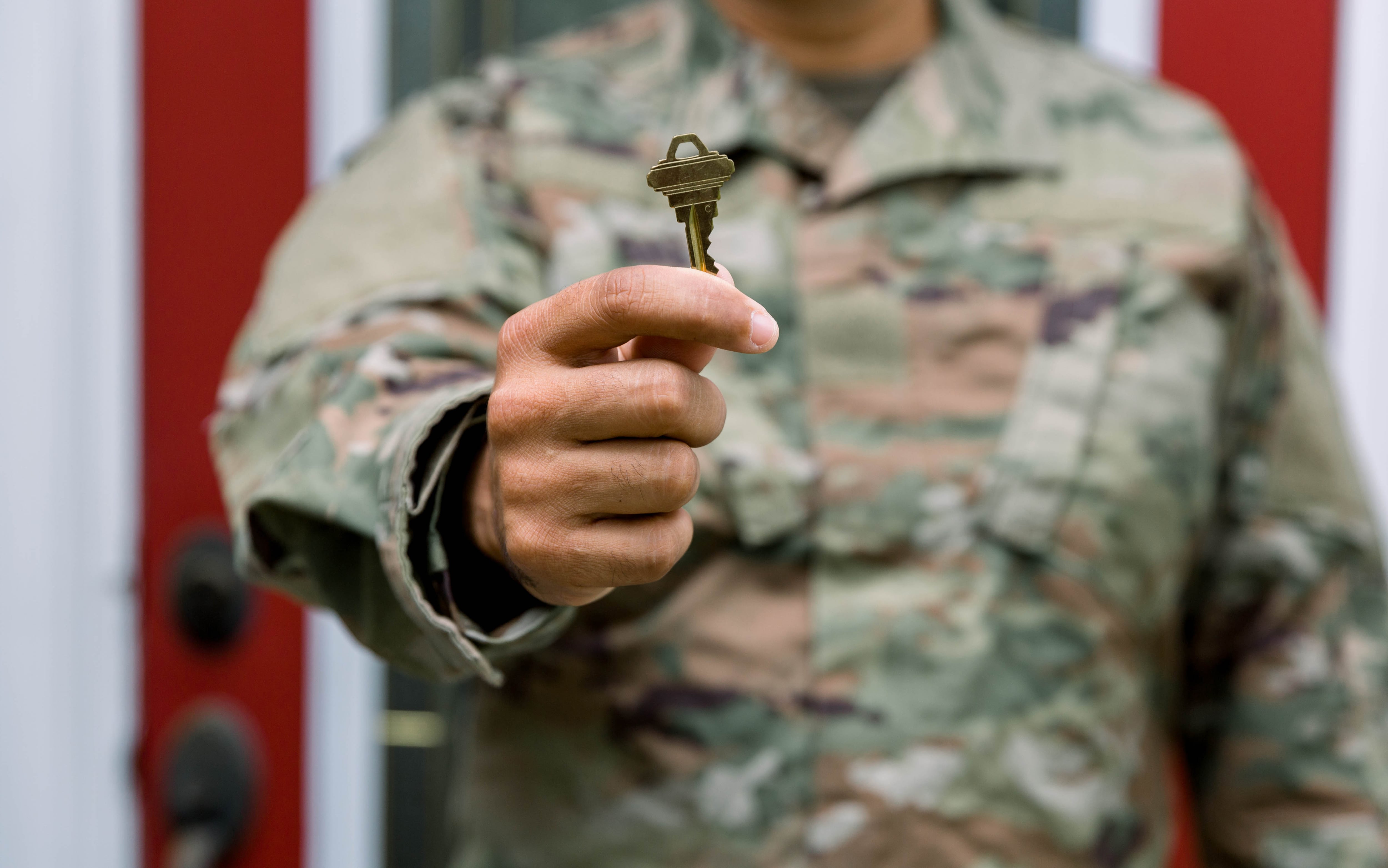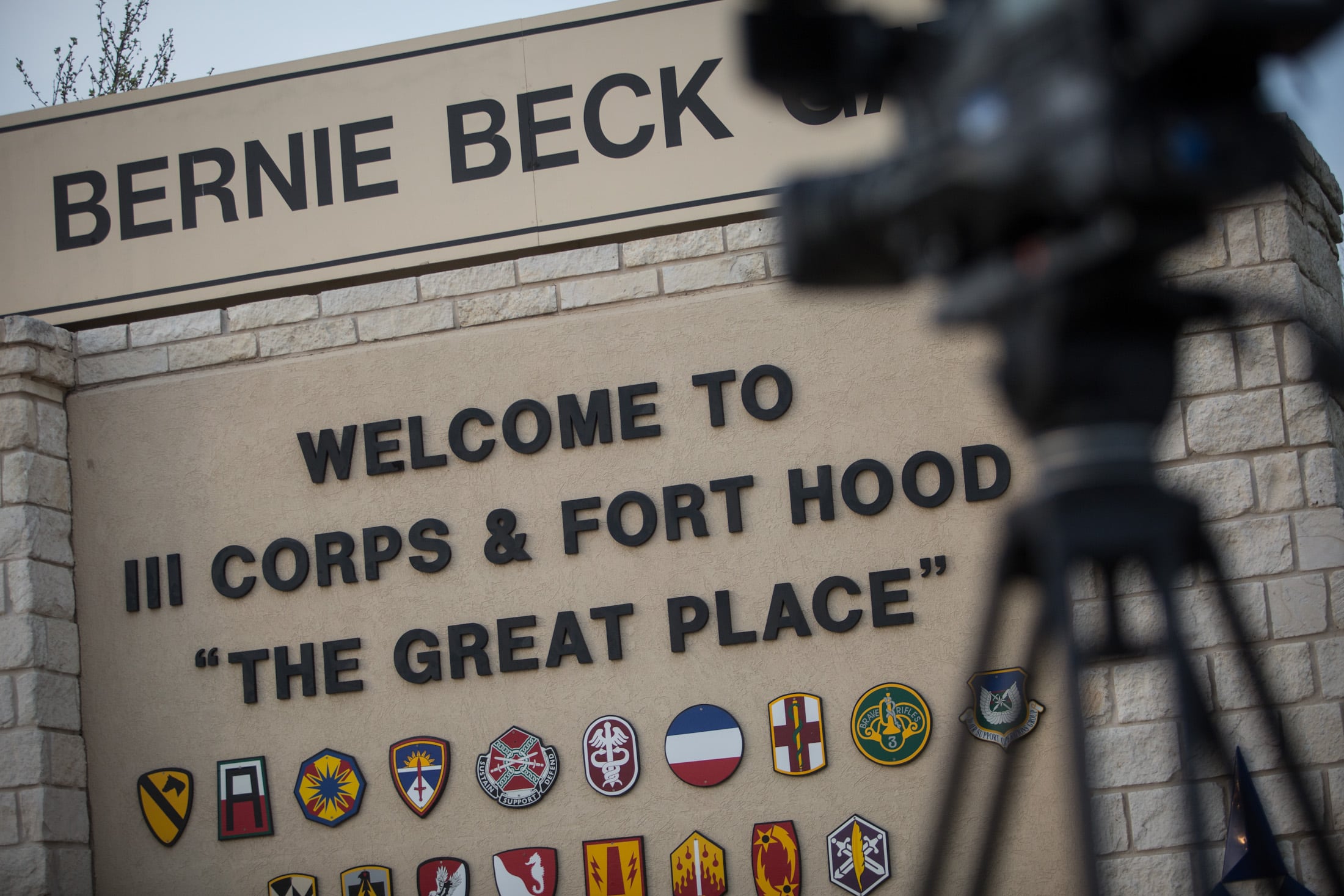Nineteen months in the job, the Navy's tophighest ranking uniformed personnel official seems to be on a roll is on a roll.
Vice Adm. Bill Moran, who took over as the chief of naval personnel in July 2013 with a mandate to fill vacant jobs manning gaps at sea, says he's cut the numbers of open billets from over 107,000 to to just over 3,000 today.
"My priorities haven't changed a bit," Moran said about his primary mandate from Chief of Naval Operations Adm. Jonathan Greenert to fix fleet manning, offering sea duty incentives and hiking career sea pay to persuade more sailors to head back to sea. He's also overseen the roll-out of hardship duty pay-tempo, which kicks in after a sailor has spent 220 days straight on deployment.
Now he's setting his sights on fixes to the body composition assessment every sailor goes through twice a year and to deliver on a handful of new uniforms, some of which have been in the works for the better part of a decade. He's not satisfied that the physical fitness assessment and the body fat measurements have enough common sense built in.
Gone is the old "Perform to Serve" re-enlistment system and in it's place is a new Career Navigator., with Moran saying that Re-enlistment opportunity is up across the fleet, Moran says. The Navy's end strength is growing, s because there's now a budget proposed that has the Navy with stable end-strength for at least the next four years, something that bodes well for not only re-enlistment, but also advancement opportunity.
He's also made it a hallmark to delegate more authority to commanding officers, such as leaving it up to COs to decide whether members of their command can wear ballcaps. set his sights on pushing as many personnel decisions down to the command level to allow command triad's — CO's, XO's and CMC's — to make the call when it comes to their own people and says efforts are ongoing to push more initiatives away from DC and Millington and back to the decollates.
He wan
ts a fit Navy, but he's not satisfied that the current Navy physical fitness assessment and body fat calculations have enough common sense built into them — so he's started efforts to find better ways to assess fitness and measure body fat.
Moran paid a visit March 4 to the Navy' Times editorial offices along with his top enlisted advisor, Fleet Master chief (AW/SW) April Beldo, to discuss the state of the Navy's Manpower, Personnel, Training and Education establishment, discussing everything he's been able to accomplish and to detail some of what he'd like to get done next.
He's got about 96 percent of the billets in the fleet filled with someone and about 93 of those with the exact rating and skill mix.
"Our numbers are up and those are aggregate numbers and we don't mean [all] individual ships and squadrons are all feeling the same thing…we know there are units out there that don't feel as well manned as they think they should be and we're working that every day."
What he's trying to do is make sea duty as rewarding as he can. In the past year, he's put extra money into sailor's pockets by upping sea pay as well as creating a new high tempo pay for those making extended deployments.
He's eliminated the uniform board and is working to push nearly a decade of old uniform initiatives off this plate and hopes to deliver a number of these uniform improvements to the fleet in the next couple fiscal years.
Moran and Beldo say they believe strongly in getting information out to sailors about what they're doing in Washington and detailed over an hour and a half of discussion updates to uniform, fitness, pay and bonuses as well as training and the ongoing efforts to bring down overmanned ratings while filling vacant billets in undermanned skills.
"If you tell a sailor the truth and let them know what's going on and what the future holds for them, then they're happy," Beldo said. "They might not agree with everything, but they know and they're happy and they'll so what you ask."
But the picture isn't all rosy, either. Some ratings are still over-manned. And all the hard work to put the Navy on a good manpower footing and new efforts to totally overhaul how and when enlisted sailors are trained is in jeopardy — along with retention — if Congress lets the Navy and her sister services slide back into sequestration, as is currently slated to happen on Jan.uary 1, 2016 unlessif no action is taken.
Though Congress exempted military pay and other manpower accounts from the sequestration axe, Moran says the heavy cuts will elsewhere in the Navy still impact the people in the service.
"We're obviously very concerned and we're watching that very closely," Moran said. "I can't say it in strong enough terms how impactful that will be on on the uncertainty levels in our fleet for sailors and their families if sequestration is not dealt with this year."
BCA changes
The Navy's height-and-weight chart is out of date, Vice Adm. Bill Moran said, and his office is getting ready to submit suggestions to Chief of Naval Operations Adm. Jon Greenert NO and Navy Secretary Ray Mabus that will change the way the Navy measures and rewardsincentivizes fitness.
The proposed changes are based on command body composition assessment statistics and feedback from the fleet, which has been vocal about its displeasure with the BCA for years.
"We run into sailors at all-hands calls who stand up and say, 'I'm a three-time failure,' and you look at them and go, 'Pretty sharp. You look good in uniform. You don't look overweight to me, at a distance,' " Moran said.
There's no doubt that body shapes have changed in the decades since the Navy wrote its height and weight chart, Moran said.
For instance, weightlifting wasn't much of a hobby when he was a junior officer, but now it's everywhere.
To get a better sense of what's healthy, he said, his office is also looking to the medical community for insight on a range of healthy bodies.
Updating the requirements, he said, will hopefully save some from separation for BCA failure, and keep others from going to extremes to make weight.
Right now, about one in three sailors has to be taped because they are over the allowable weight for their height and age.
"Because of the challenges with sea duty and a lot of the aspects of Navy life, what we find more often than not are a lot of sailors who tend to try to starve themselves or not drink water, and all those things, to get down to a height-weight standard so that they don't have to be roped and measured," he said.
Moran said the proposals are still being developed and could not elaborate on the specific changes, he will propose, but confirmed that an expansion of the height and weight chart — to include more room to put on weight as a sailor ages — as well as a change from the tape test to another body fat measurement is on the table.
In the meantime, CNP and Vice Adm. Dixon Smith, head of Navy Installations Command, are testing out whether sailors will take advantage of expanded gym hours.
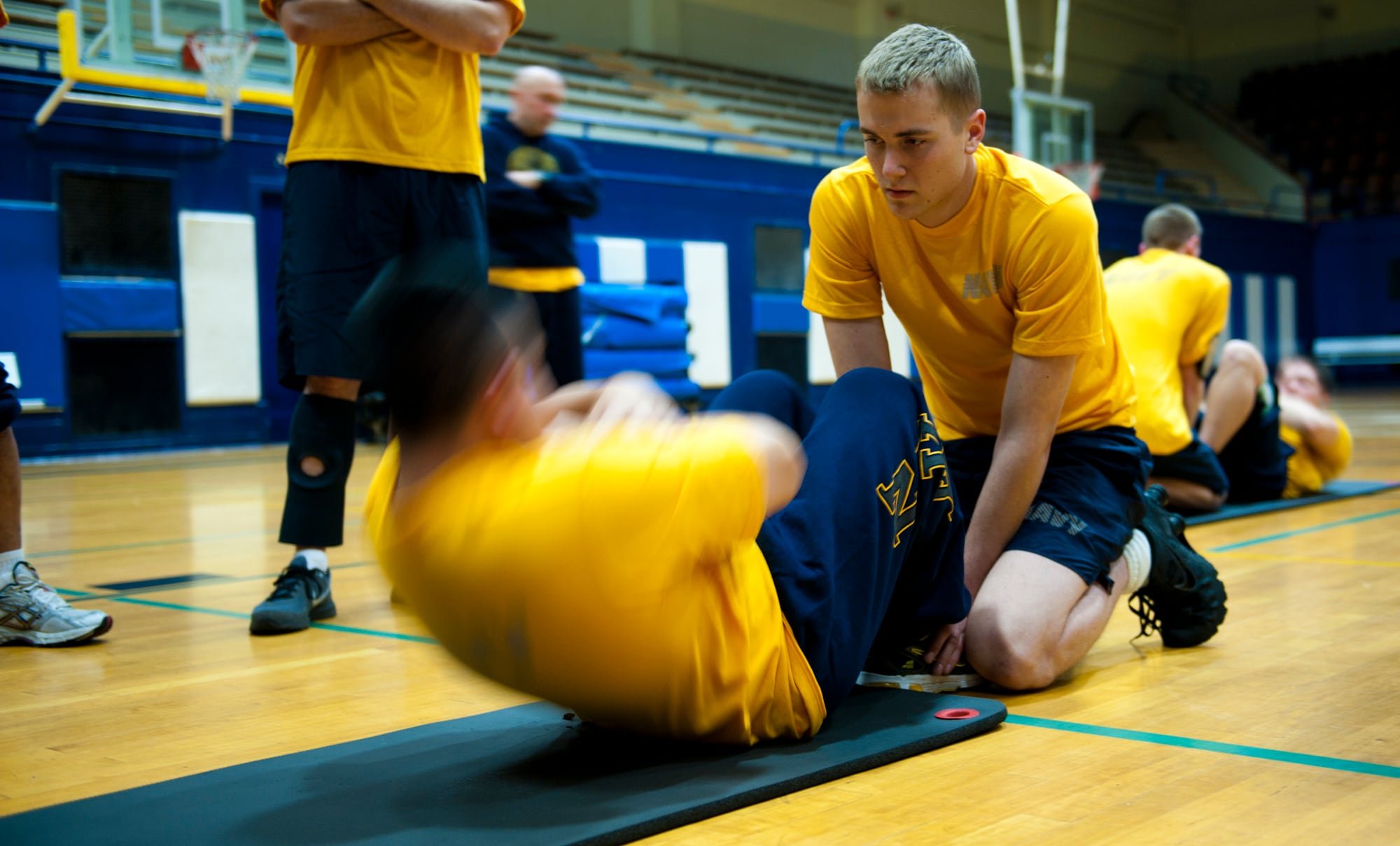
Sailors assigned to the aircraft carrier John C. Stennis practice for their physical fitness assessment. Beginning in April, gyms at Naval Base Kitsap-Bremerton will be open 118 hours a week.
Photo Credit: PO3 Kenneth Abbate/Navy
Starting in April at Naval Base Kitsap-Bremerton in Washington, base gyms will be open 118 hours a week, up from 90. earlier and close later. In addition, childcare will open two hours early and close two hours later than usual.
Bremerton is currently home to both the aircraft carriers John C. Stennis and Nimitz, which "is a challenge for the fitness center and the support facilities, so we're expanding those hours while they're there together to see if we can help them," Moran said.
The three-month pilot, coming later this year to Naval Base San Diego and Joint Expeditionary Base Little Creek in Norfolk, Virginia, will cost from $300,000 to $420,000 to keep centers opened and staffed.
Uniforms
Moran wants to bring four new uniform initiatives, most of which have been in the works for years, to completion in the next two years. He's also abolished the traditional uniform board to speed up the pipeline from conceptidea to wear test to fleet roll-out. Moran told Navy Times early in the job that he wasn't interested in taking on on too many new uniform initiatives while there were so many exiting uniform initiatives still on the table — some which have been being developed for more than a decade.
Moran now works uniform issues with He abolished the traditional uniform board and currently works these issues with with Master Chief Petty Officer of the Navy (AW/NAC) Mike Stevens and Fleet Master Chief (AW/SW) April Beldo — along with input from the fleet. Formal proposals are then taken to the CNO and Navy secretary for the final go-ahead.But it's always Greenert and Secretary of the Navy Ray Mabus who must give the final go-ahead for any final changes.
But, he and Beldo caution sailors not to count on any of these being done this fiscal year — 2016, they say, seems to be when the next round of changes will be rolled out both at boot camp and in the fleet.
Lightweight NWUs. Officials say they're close to approving the design of a tropical weight Navy working uniform. That's the case for the long-awaited lightweight version of the Navy Working Uniform as well as the cold-weather parka, both initiatives sailors in warm climates want now. But Beldo says though the efforts are moving forward, they're not ready for prime-time, yet.
"We've finished all the test wear, now we just have to get the thumbs up for us to start manufacturing and getting them on the shelf," Beldo said at the March 4 interview. "That's going to be an optional uniform for our more hot weather areas, Pearl Harbor, Bahrain and Guam. That's where they were tested."
But, she said, it's still not expected to roll out until late this year, early fiscal year 2016 at the earliest.
Cold weather parka. For those at chilly duty stations, the Navy is getting closer to adopting a black version of a Coast Guard 3-in-1 parka. It would be an optional uniform to be worn with service uniforms, like when your pea coat isn't cutting it. The wear tests are done and now the uniform needs to get a final approval from Navy leaders. Progress has been made, too, for the flip side of that — the cold weather parka, where progress has been made and tests are done, but it, too, now must get the final approval for manufacture.
"We like it and we're moving forward so we should see that one in the next year," Beldo said.
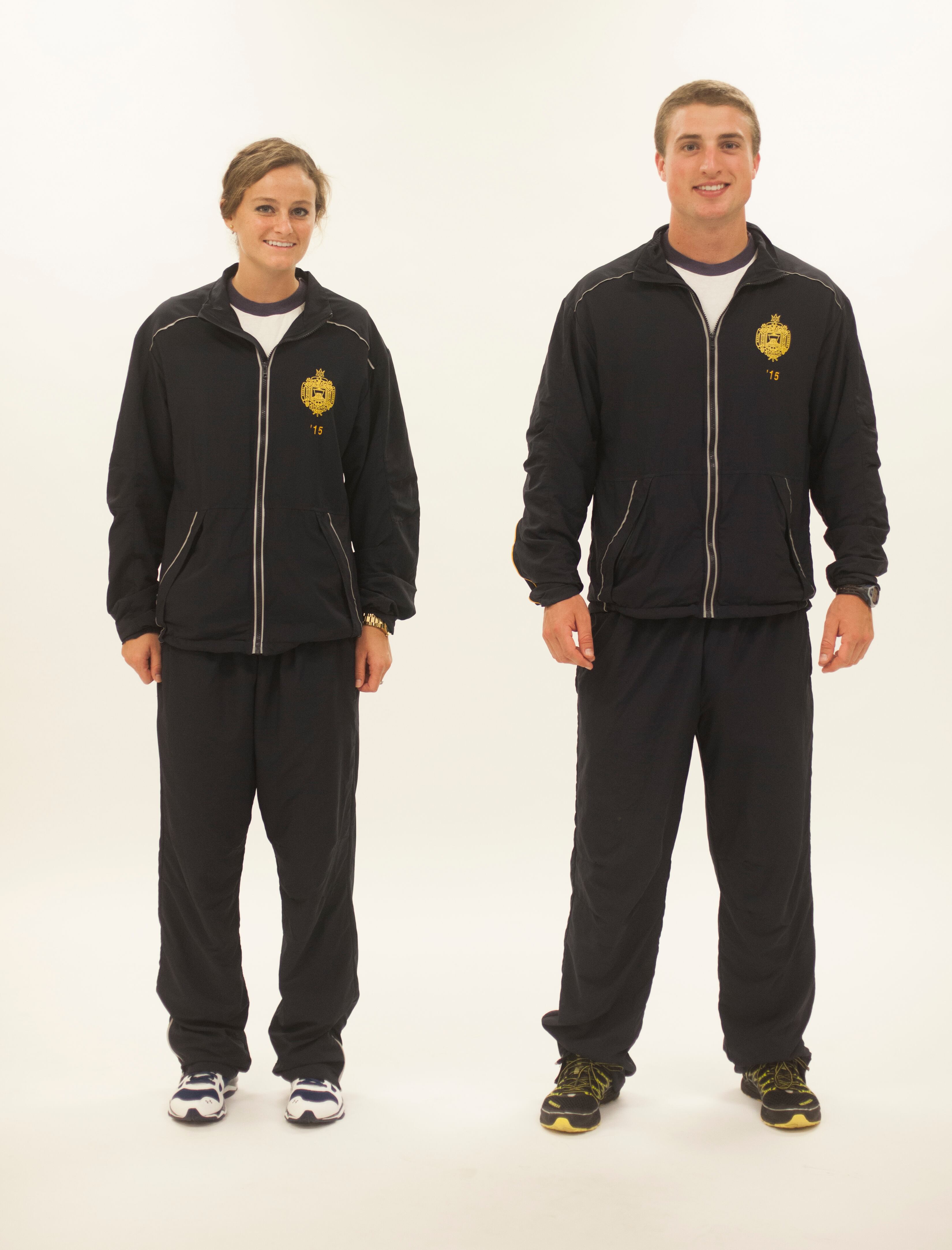
Officials plan to fast-track the running suit worn by midshipmen for the entire Navy.
Photo Credit: Mike Morones/Staff
Fitness suit. The Navy is looking to end its years-long search for high-performance outerwear to be worn with the PT uniform. The plan would adopt the moisture-wicking jogging suit worn by Marines and Naval Academy midshipmen and needs final approval before it goes forward.What seems to be the simplest of all the moves is the new fitness suits. After multiple efforts to design a Navy-specific suit haven't come together, officials decided over the past year to evaluate what's already out there among the other services.
"We looked at all the different services that have one and sometimes you don't have to re-invent the wheel," Beldo said. "So we are going to use the Marine Corps design, change the color — blue and gold — and again we could see that in fiscal year '16."
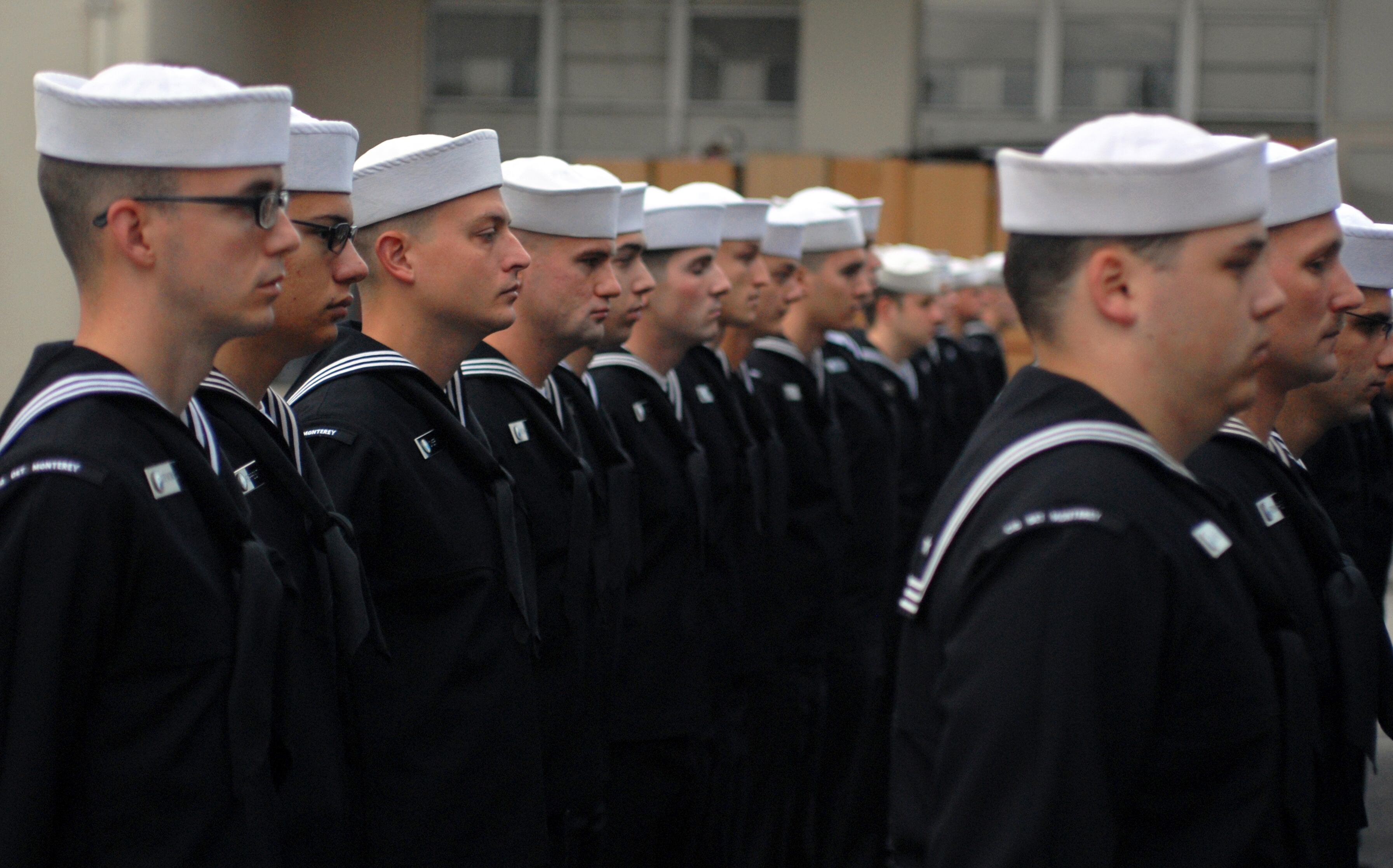
Improvements to the service dress blues and whites are in the works, says Vice Adm. Bill Moran, chief of naval personnel.
Photo Credit: MC2 Steven L. Shepard/ Navy
Crackerjacks. "The NWU efforts are relatively new to the table, but two other efforts — a fitness suit and multiple crackerjack dress uniform issues have been on the table for a decade or more. As for the E-6 and below service dress blues and whites, improvements for the men are still in the works and have been approved, but they've yet to begin production and issue while the service develops matching jumpers for women.
That's because there's another effort started in the past couple years to develop a female version of the dress blue's, an initiative kicked off by Mabus.
The improvements to the dress blues are many — installing zippers on the jumper to improve fit and make it easier to put on and take off. get a more fit and custom look to the uniform as well as making it easier to get on an off will be part of the package.They also feature Also coming are new SDB trousers, where zippers will be installed to replace the functionality of the 13-buttons on the traditional front flap.
But officials made the decision to hold up producing those up until the the research and development of the women's version is complete.
"The men's has been ready to execute for a while now, but we thought that we would do that in parallel with the female service dress," she said. "Our women are going to [crackerjack] blue — we've piloted that and gotten the feedback and ... we've gotten that and we're ready to design that."
The service dress whites are to Though both men and women sexes already wear the service dress whites, those uniforms will get a facelift, too, with the addition of jumper zippers, too as well as blue piping on the cuffs and back flap. They, too, could be ready by the end of 2016. fiscal 2016, too.
Bonuses and advancement
With the release of the 2016 budget request, the Navy made formal what had been rumored for a while, that after a decade of drawing down the service is growing back and expected to reach 330,000 by fiscal year 2020.
For those in the service and especially in undermanned skill sets, this means two things — good re-enlistment opportunity and advancement.
"Certainly this year, more of the same — good opportunity, above the 10-year average," Moran said of the two upcoming petty officer cycles. "The fact that we're growing over the next four, five years, I think we're going to be able to manage advancement over the next three to four years at about the same rate we see today."
He's also focused on evening out opportunities across all ratings. His team is alsoworking on fine-tuning information technology to better track retention in ratings by keeping nearly monthly tabs.
But officials have know that the old retention models went out the window a few years ago and predicting who will stay and who will go is getting more difficult, especially as the economy improves.
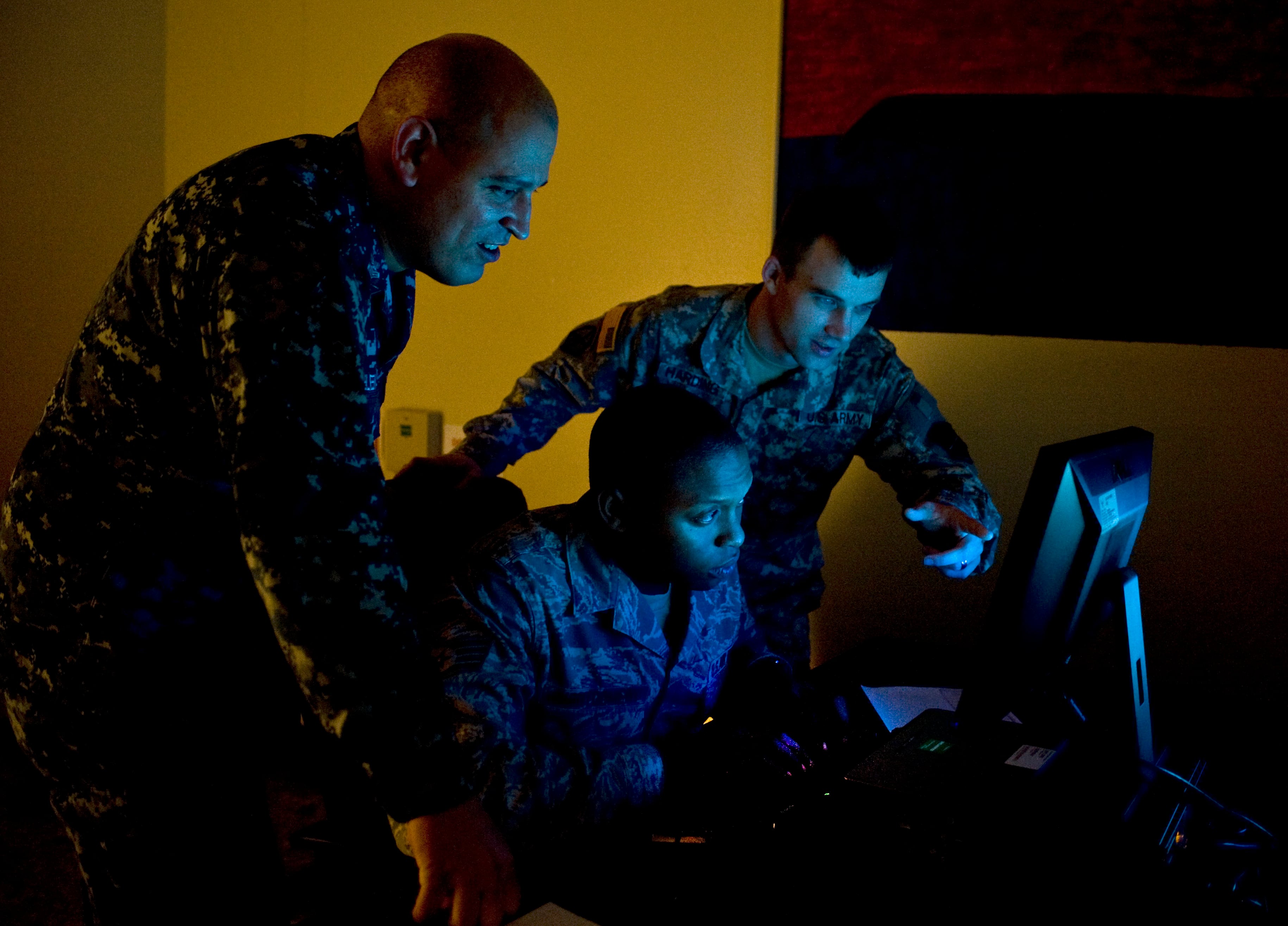
Sailors in the cybersecurity field will continue to be in high demand.
Photo Credit: A1C Matthew Lancaster/Air Force
With the economy gaining steamimproving, those in nuclear power and cyber fields will be highly sought after and the Navy is focused on retaining them.
In addition, the aviation industry is hiring again and so keeping aviators and maintainers is also expected to become a challenge.
"The airline industry has some growth potential and there is a hiring market out there that is starting to emerge,"Moran said. "I have lived through three cycles of this as an aviator — we are in another one."
His main weapon for battling with the civilian sector is bonuses and he says they'll be working with the aviation community managers to ramp up aviation incentive pays for pilots, he said.
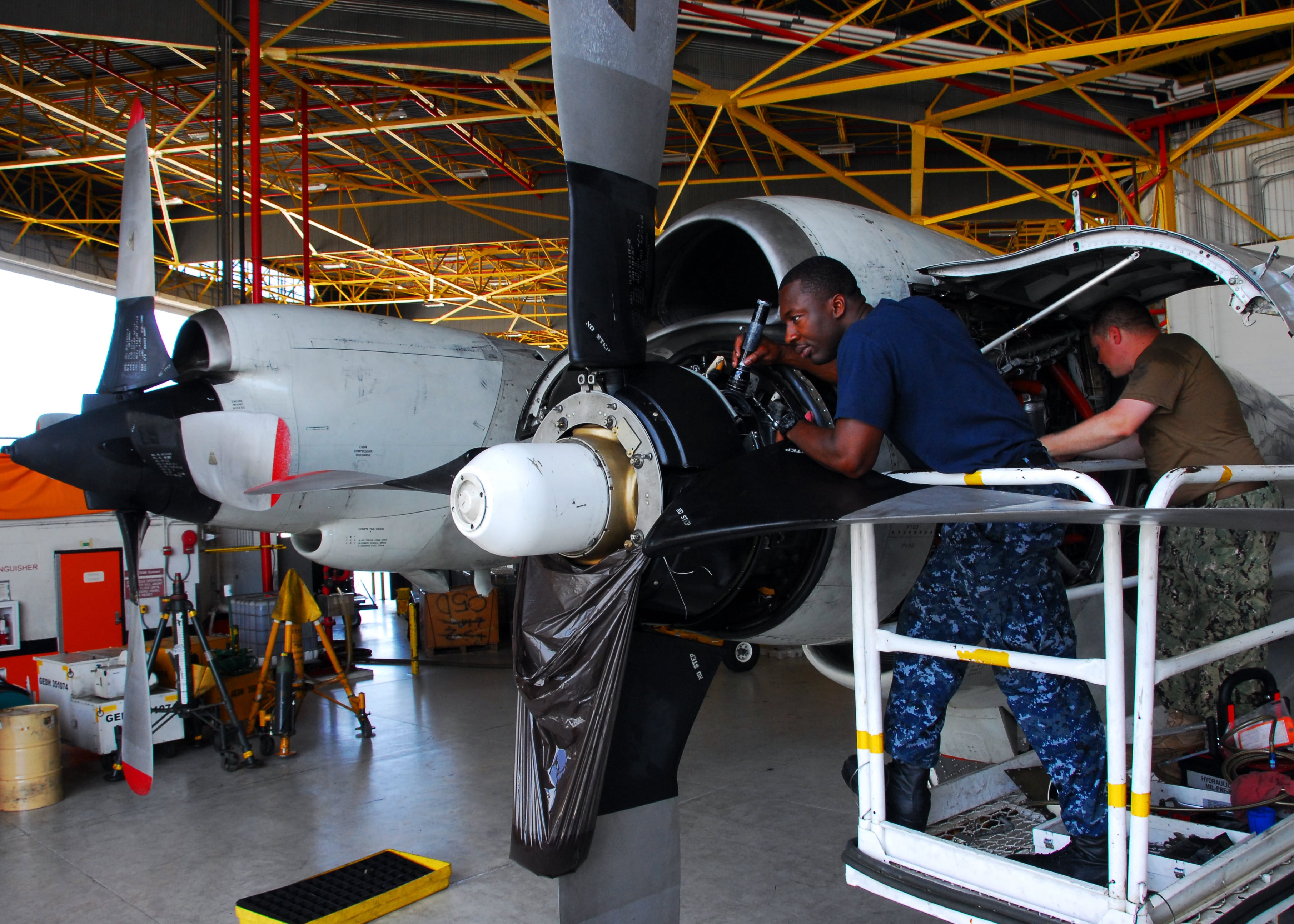
Aviation machinist's mates change the propeller on a P-3C Orion. The aviation industry is hiring, so keeping maintainers is expected to become a challenge.
Photo Credit: MC2 Clay M. Whaley/Navy
He's also focused on being able to quickly adjust selective re-enlistment bonuses, to react to individual ratings.
"It wasn't too long ago that we were doing SRB changes every couple years — now we're doing it once a year and I'd like to see it get to twice a year," Moran said.
Key to this are his efforts to create an IT system that can dig into individual ratings and detect trends as they're happening, allowing them to make quick adjustments.
Those in special warfare and the nuclear and cyber fields can continue to count on large bonuses. But for most others, the service is looking to spread the bonus cash around to influence the retention behavior more widely.
"We should be able to see change in behavior a lot sooner than we have in the past. And once we do, then we can make SRB adjustments every six months and fine-tune them to account for behavior, which has been a challenge."
Meanwhile, recruiting is becoming more challenging.The retention focus arises, in part, because it's easier to retain skills then to train new sailors off the street. Already, he says, they're seeing a slip in recruiting behavior.
"Some of what we're seeing in the recruiting market now has us concerned," he said. "Even though we're continuing to make goal, it's coming later in the month, each month."
Entrance test scores among recruits are also starting to drop.
"Our ASVAB scores have been at historic highs over the last several years [and] are starting to creep down," he said. "Those are things we have to pay attention to."
Mark D. Faram is a former reporter for Navy Times. He was a senior writer covering personnel, cultural and historical issues. A nine-year active duty Navy veteran, Faram served from 1978 to 1987 as a Navy Diver and photographer.
Meghann Myers is the Pentagon bureau chief at Military Times. She covers operations, policy, personnel, leadership and other issues affecting service members.


